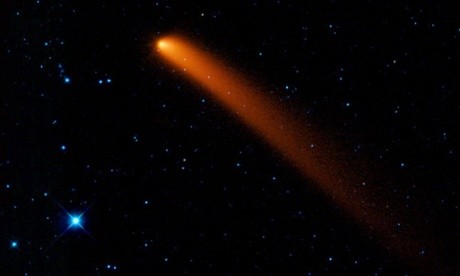Earth Left with Huge Blind Spot After Comet-spotting Program's Funding Gets Cut
| Dino Lirios | | Oct 20, 2014 08:23 AM EDT |
(Photo : NASA, JPL-Caltech, UCLA/AAP)
The dedicated comet-spotting program - the NASA-funded Australian survey - has been closed down, leaving the Earth with a huge blind spot for catastrophic comet strikes.
The program had previously discovered the Siding Spring comet that just narrowly missed Mars recently. It was stationed on the southern hemisphere and had to close down because it lost their funding.
Like Us on Facebook
It was the only program in the southern hemisphere searching for hazardous comets, asteroids, and meteors.
Bradley Tucker, an astronomer at the Australian National University (ANU) and University of California Berkeley said that this is something to worry about.
"There could be something hurtling towards us right now and we wouldn't know about it," Tucker said.
Potentially hazardous asteroids (PHA) are defined as celestial objects that pass within 7.4 million kilometers of the Earth and are more than 150 meters in diameter. There are a reported 1,508 known cases so far.
The largest and possibly most famous asteroid that struck Earth landed in Mexico about 65 million years ago. This asteroid is believed to have caused the extinction of the dinosaurs.
In recent times, a 20-meter meteor entered the Earth's atmosphere. No one was able to detect as it made its way 30 kilometers above Chelyabinsk in Russia and exploded in the air, injuring 1,500 people.
Tucker likened the explosion to a nuclear bomb gong off in the atmosphere, stressing that there could be inconceivable damage if a similar meteor would hit a populated area.
The now-defunct survey was led by Dr. Robert McNaught, a Scottish-Australian scientist credited with discovering over 475 asteroids, 82 comets, and 16 objects. This is more than any other astronomer.
A savage bushfire around the Siding Spring observatory nearly ended the program last January. Around the time, NASA was already pulling the funding, but ANU had donated to keep the funding alive.
However, something had to give, and eventually all avenue for money was gone.
Siding Spring's partner site in Arizona continues to operate, with their sights trained on the northern hemisphere. However, it will not be able to see objects in the southern sky.
Currently, scientists are also researching on several means of averting approaching celestial bodies that could damage the Earth.
TagsNASA, Siding Spring, Blind spot, comet, asteroids, comet-spotting program, Funding, cut
©2015 Chinatopix All rights reserved. Do not reproduce without permission
EDITOR'S PICKS
-

Did the Trump administration just announce plans for a trade war with ‘hostile’ China and Russia?
-

US Senate passes Taiwan travel bill slammed by China
-

As Yan Sihong’s family grieves, here are other Chinese students who went missing abroad. Some have never been found
-

Beijing blasts Western critics who ‘smear China’ with the term sharp power
-

China Envoy Seeks to Defuse Tensions With U.S. as a Trade War Brews
-

Singapore's Deputy PM Provides Bitcoin Vote of Confidence Amid China's Blanket Bans
-

China warns investors over risks in overseas virtual currency trading
-

Chinese government most trustworthy: survey
-

Kashima Antlers On Course For Back-To-Back Titles
MOST POPULAR
LATEST NEWS
Zhou Yongkang: China's Former Security Chief Sentenced to Life in Prison

China's former Chief of the Ministry of Public Security, Zhou Yongkang, has been given a life sentence after he was found guilty of abusing his office, bribery and deliberately ... Full Article
TRENDING STORY

China Pork Prices Expected to Stabilize As The Supplies Recover

Elephone P9000 Smartphone is now on Sale on Amazon India

There's a Big Chance Cliffhangers Won't Still Be Resolved When Grey's Anatomy Season 13 Returns

Supreme Court Ruled on Samsung vs Apple Dispute for Patent Infringement

Microsoft Surface Pro 5 Rumors and Release Date: What is the Latest?










